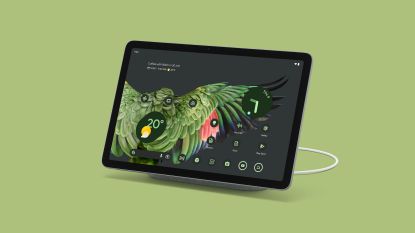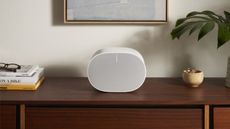Taking Google’s sleek Pixel Tablet for a test run
The Google Pixel Tablet is a premium slice of media tech, complete with speaker dock that transforms it into the central hub of a smart home set-up

Is the new Google Pixel Tablet in it for the long haul? The company is the tech-world equivalent of that handsome rich kid at school who'll try anything once, however outlandish, and then face absolutely no consequences whatsoever when they crash and burn (there's even a whole website dedicated to abandoned projects, Killed by Google). As Google pivots towards creating hardware to better deliver the software that shapes, guides and controls our lives, it was inevitable that a dedicated tablet would be in the works.
The first Google tablets were branded Nexus 7 and released in 2012, just as interest in the company’s Android operating system started to snowball. These days, Android is the dominant mobile OS, with over 70 per cent market share, and Android tablets are two a penny, whether they’re sleek premium devices from Lenovo and Asus, or one of the myriad knock-off designs of dubious origin and quality that clog up Amazon search results.

The case is designed to function with the dock
When it builds hardware, Google pitches itself at the premium end of the market. Its Pixel Chromebook was of legendarily tough construction, and the current generation of Pixel phones are constructed to tough standards. The new Pixel Tablet feels similarly solid, although the rugged hardcase with built-in stand is an expensive extra. That said, you do get a Charging Speaker Dock, a welcome addition that transforms this device from simple media player to all-round smart home hub.
The Pixel Tablet clips magnetically onto the dock, which charges as well as directs the sound through the large speaker. Then it’ll enter hub mode, which replicates the features of Google’s earlier Nest Hub, albeit with a bigger screen, better sound and the ability to take the screen with you. The size is pretty optimum as well, not so large as to be unwieldy.

The Google Pixel Tablet on its charging dock
Hub mode is where you access Google Assistant, that font of trivia, train times and weather reports, although you can of course set it to spool through a Google-curated gallery or your own photo reel. The addition of the dock makes this tablet a cut above the rest (although a spare USB-C socket would have been a nice addition to the cloth-coated base unit).
Otherwise, this is a smart, snappy and thoroughly useful screen to have lying around. Powered by Google’s own Tensor G2 chip, it makes light work of streaming, with a crisp 2560 x 1600 resolution 11in screen and integral speakers that are more than sufficient for casual watching. The forward-facing camera works with Google’s Meet video calling system, and there’s the added bonus of being able to stream media from your phone to the dock with Chromecast.

The Google Pixel Tablet case has an integral looped metal stand
All in all, the Pixel ecosystem feels exceptionally mature and well thought out, with the 13th iteration of Android a smooth and minimal experience. Pixel Tablet is available in either Hazel or Porcelain colourways, with 128 or 256GB storage. The front and rear cameras are boosted by Google Photos’ impressive set of editing tools; compatibility with the latest USI 2.0 stylus pens also adds to the functionality. The only thing that’s missing is a keyboard case, possibly because Google is pitching the Pixel Tablet as a multimedia machine first and foremost. The aftermarket will surely conjure up some options before long.

The charging base contains a speaker
Google Pixel Tablet, from £599, Store.Google.com
Also available from amazon.co.uk
Jonathan Bell has written for Wallpaper* magazine since 1999, covering everything from architecture and transport design to books, tech and graphic design. He is now the magazine’s Transport and Technology Editor. Jonathan has written and edited 15 books, including Concept Car Design, 21st Century House, and The New Modern House. He is also the host of Wallpaper’s first podcast.
-
 Blue Nomad Floating Habitat is a prototype dwelling for a drowning world
Blue Nomad Floating Habitat is a prototype dwelling for a drowning worldInspired by traditional ocean-going vessels, the Blue Nomad Floating Habitat is a prototype dwelling for a drowning world, shaped by students from Rosenberg
By Jonathan Bell • Published
-
 A Hermosa Beach house by XTEN champions minimalist beachside living
A Hermosa Beach house by XTEN champions minimalist beachside livingStrandhouse by XTEN is a Hermosa Beach house designed to offer minimalist surrounds and the best architectural accompaniment to its seaside location
By Ellie Stathaki • Published
-
 Mercedes EQE SUV brings more tech to the fore
Mercedes EQE SUV brings more tech to the forePremium electrification means imposing scale and unavoidable technology in the all-conquering Mercedes EQE SUV
By Rory FH Smith • Published
-
 Portable and pocketable travel tech: four take-away gadgets with which to stay connected
Portable and pocketable travel tech: four take-away gadgets with which to stay connectedWork and play remotely with these travel tech devices: TicWatch Pro 5; a stylish new Samsung battery pack; Urbanears’ latest earbuds; and the evergreen Tula microphone
By Jonathan Bell • Published
-
 Audio-Technica adds new hues to its classic Sound Burger record player
Audio-Technica adds new hues to its classic Sound Burger record playerThe Audio-Technica Sound Burger offers portable analogue audio for all, with a colour menu that nods to the bold electronics of the 1980s
By Jonathan Bell • Published
-
 Leica Q3 full-frame digital camera brings new speed and sophistication
Leica Q3 full-frame digital camera brings new speed and sophisticationThe new Leica Q3 camera boasts features that pitch it at both photographers and filmmakers
By Jonathan Bell • Published
-
 High-fidelity meets high design in eight new speaker systems
High-fidelity meets high design in eight new speaker systemsFrom room-filling sub-woofers to elaborate sculptural objects, speaker systems have never been so diverse. We round up eight key players in the modern audio space
By Jonathan Bell • Published
-
 Sonos sets its sights on new sonic horizons with the Era 100 and Era 300 smart speakers
Sonos sets its sights on new sonic horizons with the Era 100 and Era 300 smart speakersThe new Sonos Era speakers expand the company’s family of high-end streaming devices, as well as introducing Dolby Atmos and decreasing its carbon footprint
By Jonathan Bell • Published
-
 Flip phones make a comeback, from old-school revivals to sleek folding screens
Flip phones make a comeback, from old-school revivals to sleek folding screensAs Mobile World Congress 2023 gives the tech industry its annual shake-up, we’ve rounded up the current crop of flip phones for minimally-minded users
By Jonathan Bell • Published
-
 Seven new laptops offer power and portability to lust after
Seven new laptops offer power and portability to lust afterA clutch of cutting-edge new laptops was highlighted at CES 2023, bringing new form factors and technologies
By Jonathan Bell • Published
-
 CES 2023: nine new devices to desire
CES 2023: nine new devices to desireSome of the best concepts and launches of CES 2023, from a folding e-scooter to customisable Playstation5 controls and a cute patrolling petbot
By Jonathan Bell • Published










